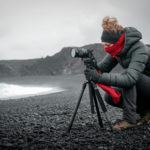In an era when digital photos can be taken with everything from DSLR cameras and phones to even watches you wear on your wrist, it’s difficult to imagine taking photos with analog cameras and developing the film yourself in a modern photography workflow. This, however, is a challenge that Lukas Fritz took on:
If you take some time to look through the Fritz’s YouTube archive, you’ll quickly notice that he has a passion for building small engineering projects. His latest one is the Filmomat, an automatic color film processor.
The instructions are pretty simple: you just fill the main canister with water, and the three smaller containers with the developing solutions, then select the appropriate program, sit back, and wait for the machine to do all the work.

Even though the Filmomat is homemade, it looks very professional.
I can’t help but feel like this is a small piece of a disappearing art, and I’m glad that someone is doing something to take analog photos into the 21st century.
What do you think, should the Filmomat be mass-produced? Would you buy one and start taking analog photos?
Like This Article?
Don't Miss The Next One!
Join over 100,000 photographers of all experience levels who receive our free photography tips and articles to stay current:






A camera-store owner friend of mine used to process color film for the high school photography class (they did their own B&W, but C-47’s a touchy process). He’s got a 1980’s “mini” lab that he could easily keep in good repair–unlike that newer, high-tech machines they built later. He drained them years ago ’cause there just wasn’t enough film business to justify all the chemistry it needed to run. A little baby like this would be idea for small-town, independent photo stores that only see a roll or three every few months. Heck, I’d like one, too (but I don’t have the money right now).
Problem is, I heard the EPA idiots got the chemistry for color printing outlawed, and what’s the point of developing film if you have to digitize it in order to print it anyway?
I would like to buy one.
As an old geezer who used to do this in tanks in both Black & White and Color films, it doesn’t mean a thing until you can show me the print or digitize it to the computer for photoshop. I’d still be in a dark room after mixing more chemicals.